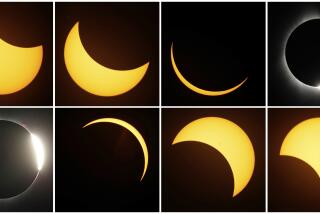Has comet ISON survived its solar flyby?
Has Comet ISON survived its suicidal flyby of the sun? Scientists expected the dirty snowball to break apart as it flew within 730,000 miles of the sun on Thanksgiving, but NASA reported Friday that its nucleus may have survived.
“As ISON appeared to dim and fizzle in several observatories and later could not be seen at all by NASA’s Solar Dynamics Observatory or by ground based solar observatories, many scientists believed it had disintegrated completely,” read a NASA statement.
“However, a streak of bright material streaming away from the sun appeared in the European Space Agency and NASA’s Solar and Heliospheric Observatory later in the evening. The question remains whether it is merely debris from the comet, or if some portion of the comet’s nucleus survived, but late-night analysis from scientists with NASA’s Comet ISON Observing Campaign suggest that there is at least a small nucleus intact,” NASA said.
PHOTOS: Comet ISON journeys through the solar system
Earthlings have been tracking the comet’s journey for more than a year after Russian astronomers first spotted the brilliant object. Nearly two dozen spacecraft, including NASA’s Hubble and Spitzer telescopes, have trained their eyes on ISON and eagerly awaited its date with oblivion -- or not.
When ISON passed by Mars, instruments aboard the Mars Reconnaissance Orbiter measured its nucleus as about two-thirds of a mile across, relatively small by comet standards. The nucleus is made of ice and space dust.
The comet originated from the distant, icy reaches of the solar system, in a region known as the Oort Cloud, scientists say. Its journey began an estimated 5 1/2 million years ago. On Thursday it encountered temperatures of 5,000 degrees Fahrenheit as it reached perihelion, the point at which its orbit is closest to the sun.






